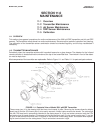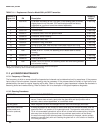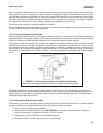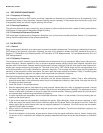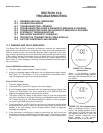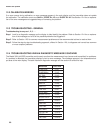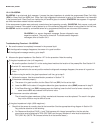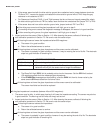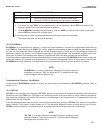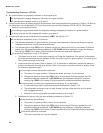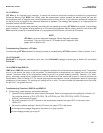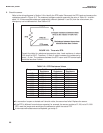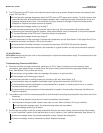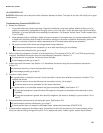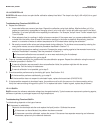
93
MODEL 3081 pH/ORP SECTION 12.0
TROUBLESHOOTING
SLOPE STATUS OF SENSOR
54-60 mV/unit pH Sensor is in good condition.
48-50 mV/unit pH Sensor is nearing the end of its life. Once the slope drops
below 48 mV/unit pH, the sensor can no longer be calibrated.
b. The Glass Fail High (GFH) limit is probably set too low for the sensor. Set the GFH limit to about 150
megohms greater than the measured glass impedance.
c. If the GLASSWArn message was also flashing, raise the GWH limit from its former value by the same
amount GFH was raised from its former value.
If cleaning does not lower the glass impedance and the sensor cannot be calibrated...
The sensor has failed and should be replaced.
12.4.2 GLASSWArn
GLASSWArn is an electrode fault message. It means the glass impedance is outside the programmed Glass Warning
High (GWH) or Glass Warning Low (GWL) limit. Ideally, when the measurement system exceeds the glass warning limits,
the user will have adequate time to diagnose and correct problems before a failure occurs. High impedance implies the
electrode is aging or the sensor is not completely submerged in the process liquid. Low impedance suggests the pH sen-
sitive glass is cracked. The message also appears if inappropriate limits have been entered into the transmitter.
If the measurement system was previously commissioned and operating correctly, GLASSWArn likely means a real prob-
lem exists. However, if the system is being started up or if the advanced diagnostic feature is being used for the first time,
GLASSWArn could be caused by a miswired sensor or by programmed limits that are not correct for the sensor.
NOTE
GLASSWArn is a sensor diagnostic message. All sensor diagnostic
messages are optional. They can be turned off. To disable sensor diag-
nostic messages, refer to Section 8.4.3.
Troubleshooting Flowchart - GLASSWArn
Troubleshooting GLASSWArn problems is exactly the same steps as troubleshooting GLASSFAIL problems. Refer to
Section 12.4.1.
12.4.3 rEF FAIL
rEF FAIL is an electrode fault message. rEF FAIL means that the reference impedance exceeds the programmed
Reference Fault High (RFH) limit. A plugged or dry reference junction is the usual cause of a high reference impedance.
High reference impedance also occurs if the sensor is not submerged in the process liquid or if inappropriate limits have
been entered into the transmitter.
If the measurement system was previously commissioned and operating correctly, rEF FAIL likely means a real problem
exists. However, if the system is being started up or if the advanced diagnostic feature is being used for the first time,
rEFFAIL could be caused by a miswired sensor or by programmed limits that are not correct for the sensor.
NOTE
rEF FAIL is a sensor diagnostic message. All sensor diagnostic mes-
sages are optional. They can be turned off. To disable sensor diagnostic
messages, refer to Section 8.4.3.



